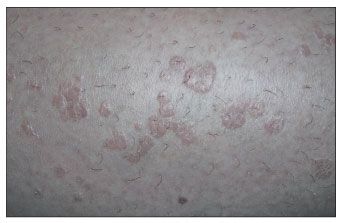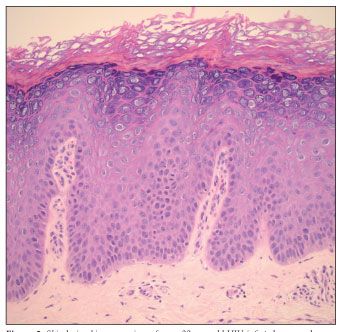- Clinical Technology
- Adult Immunization
- Hepatology
- Pediatric Immunization
- Screening
- Psychiatry
- Allergy
- Women's Health
- Cardiology
- Pediatrics
- Dermatology
- Endocrinology
- Pain Management
- Gastroenterology
- Infectious Disease
- Obesity Medicine
- Rheumatology
- Nephrology
- Neurology
- Pulmonology
Extensive Development of Flat Warts as a Cutaneous Manifestation of Immune Reconstitution Syndrome
Cutaneous manifestations of immune recovery in response to highly active antiretroviral therapy may account for up to 54% to 78% of the clinical presentations of the immune reconstitution syndrome (IRS)
HIV-related immune reconstitution syndrome (IRS) has been observed in connection with multiple opportunistic pathogens, including mycobacteria, viruses, and fungi.1-4 It has been estimated that 10% to 25% of patients who receive highly active antiretroviral therapy experience IRS.5,6 Patients with IRS often present with atypical manifestations of disease compared with the typical opportunistic infection presentations observed in the pre-HAART era. IRS is suggested by a vigorous virological response to antiretroviral therapy, a rapid CD4 count increase in a patient with a very low initial CD4 count, and an unusual manifestation of an existing opportunistic infection or a new diagnosis of an opportunistic infection.1,6-8
Cutaneous manifestations of IRS are considered to be protean and may account for up to 54% to 78% of the clinical presentations of the syndrome.3,5,6 Genital herpes, varicella-zoster virus infection, genital warts, and molluscum contagiosum represent the majority of cutaneous manifestations. Inflammation of preexisting cutaneous warts in response to antiretroviral therapy has also been described.6 We report a case of extensive cutaneous warts, specifically verruca plana, observed after the initiation of antiretroviral therapy in a patient without history of cutaneous warts.
CASE SUMMARY
A 38-year-old woman received a diagnosis of HIV infection in January 2007, with a CD4+ cell count of 8/µL, CD4% of 1%, HIV RNA level of 578,675 copies/mL, CD8+ cell count of 415/µL, CD8% of 54%, and CD4:CD8 ratio of 0.019. Highly active antiretroviral therapy was initiated with efavirenz, abacavir, and lamivudine. One month after the initiation of therapy, her CD4+ and CD8+ cell counts had increased to 87/µL and 754/µL, respectively. Her CD4% increased to 6%, and her HIV RNA level dropped to 329 copies/mL. Her CD8% decreased to 52% and CD4:CD8 ratio increased to 0.115. At the same time, numerous erythematous, smooth, slightly elevated, flat-topped papules developed primarily on her forearms and lower legs (Figure 1). The patient stated that she never had warts but that her children had similar lesions.

Figure 1.Numerous papules primarily on the lower leg of a 38-year-old HIV-infected woman.
A biopsy specimen of the lesions demonstrated typical characteristics of a flat wart (verruca plana): basketweave orthokeratosis alternating with parakeratosis (persistence of the nuclei of keratinocytes as they rise into the stratum corneum), acanthosis (benign thickening of the stratum spinosum), minimal papillomatosis, and a uniformly thickened granular cell layer with slight vacuolization of cells in the granular and upper basal cell layer layers (Figure 2). No new eruptions occurred after the first crop of lesions.

Figure 2.Skin lesion biopsy specimen from a 38-year-old HIV-infected woman demonstrating typical characteristics of a flat wart: basketweave orthokeratosis alternating with parakeratosis (persistence of the nuclei of keratinocytes as they rise into the stratum corneum), acanthosis (benign thickening of the stratum spinosum), minimal papillomatosis, and a uniformly thickened granular cell layer (hematoxylin-eosin stain, original magnification x100).
The patient was successfully treated for some of the most noticeable lesions on her forearms with liquid nitrogen applications. The lesions on her legs were still present after 4 months of antiretroviral therapy, at which time her CD4+ cell count was 105/µL, CD4% was 5%, HIV RNA level was 180 copies/mL, CD8+ cell count was 1180/µL, CD8% was 56%, and CD4:CD8 ratio was 0.089.
DISCUSSION
The prevalence of skin disorders has been reported to range from 63% to 92% among all HIV-infected persons.4,9,10 Cutaneous warts have been described in 2.9% to 7.7% of the HIV-infected population,2,4,9 -12 with these prevalence rates considered to be higher than those in the HIV-negative population.11 Genital warts occur in 3% to 8% of HIV-infected persons.2,4,11 Despite their common occurrence, warts are rarely reported in the setting of IRS.
In a recently published review of 199 patients who started antiretroviral therapy, 44 (22%) experienced a total of 51 immune reconstitution inflammatory syndrome (IRIS) events in the 6 months after initiation of therapy.5 Of the total IRIS presentations, 78% were dermatological manifestations. The most common event was anogenital herpes simplex, which occurred in 22 patients (50%). In addition, 10 patients (23%) had genital warts, 4 (9.1%) had molluscum contagiosum, and 4 (9.1%) had varicella-zoster virus infection. The median time to the onset of IRIS-related cutaneous manifestations was 13 weeks.
We found only one other case of efflorescence of cutaneous warts as a manifestation of IRIS.13 A treatment-experienced patient with an initial CD4+ cell count of 2/µL and an HIV RNA level of 96,000 copies/mL was started on a regimen of lopinavir/ritonavir coformulation plus the fixed-dose combination of abacavir/ zidovudine/lamivudine. After 4 weeks, the patient's CD4+ cell count increased to 31/µL and his HIV RNA level decreased to below 200 copies/mL. At the same time, painful disseminated keratotic nodules developed on the patient's limbs and face. Biopsy specimens of the lesions revealed typical human papillomavirus (HPV) infection. Lesions improved with occlusive topical application of cidofovir.
As in the patient reported above, cutaneous warts developed in our patient 4 weeks after initiation of antiretroviral therapy. Our patient presented with the least common of the 3 types of cutaneous warts: juvenile, or flat, warts (verruca plana). In the non–HIV-infected population, flat warts account for 4% of cutaneous warts in comparison with common warts (verruca vulgaris), which are observed in 71% of cutaneous presentations and plantar warts (verruca plantaris) seen in 34% of cases.14 Flat warts are most commonly associated with HPV types 3 and 10; common and plantar warts, with HPV types 1 and 2.14 Of interest, Goodman and colleagues11 observed the same frequency of 3% in prevalence of common and flat warts in his group of HIV-positive patients.
Another study showed that 33 of 132 patients (25%) who had a greater than 1 log10 copies/mL decrease in their plasma HIV RNA levels during the first 16 weeks of therapy had 1 or more episodes of IRS.6 Eighteen of the 33 patients (55%) presented with cutaneous manifestations of immune reconstitution. Inflammation of existent cutaneous warts-but no new appearances of lesions-was described in 3 patients (9%). The other manifestations included dermatomal zoster in 7 patients (21%), herpes in 7 (21%), and inflamed molluscum contagiosum in 2 (6%). No genital warts were reported in this cohort.
In a study of HIV-infected patients coinfected with Mycobacterium tuberculosis, increases in CD4% and CD4:CD8 ratio after 1 month of antiretroviral therapy, rather than an increase in CD4+ cell count, were the only factors independently associated with IRS.15 That study raises the issue of the possible unbalanced T-cell response in the pathogenesis of IRS. Our patient demonstrated not only an increase in his absolute CD4+ cell count from 8/µL to 87/µL but also increases in his absolute CD8+ cell count and CD4:CD8 ratio.
It has been reported that many dermatological manifestations of HIV infection correlate with the degree of immunosuppression. Seborrheic dermatitis, molluscum contagiosum, herpes simplex, and eosinophilic folliculitis usually occur in patients with CD4+ cell counts less than 50/µL.2 Cutaneous manifestations of IRS have been noted to reappear at similar CD4+ cell counts during reconstitution of the immune system.3 Rodriguez and colleagues16 reported that the mean absolute CD4+ cell count was lower in HIV-positive patients with persistent warts (141/µL) than in those with regressed warts (411/µL) (P = .01). Goldstein and colleagues2 reported that condyloma acuminatum occurrence correlated with a mean CD4+ cell count of 74/µL, but they found no statistically significant correlation in incidence of cutaneous warts and CD4 count. The absence of a reliable correlation between CD4 count and the incidence of warts may partially explain why cutaneous warts are not consistently described as a manifestation of IRS.
The sudden development of extensive flat warts in our patient, which coincided with robust immune reconstitution in response to antiretroviral therapy, suggests that this represented IRS. The unexpected appearance of a skin eruption might have a profound psychological effect on the patient and surprise the physician as well. The possibility of cutaneous symptoms after the initiation of antiretroviral therapy should be considered and discussed with patients starting treatment.
No potential conflict of interest relevant to this article was reported by the authors.
References:
References1. Hirsch HH, Kaufmann G, Sendi P, Battegay M. Immune reconstitution in HIV-infected patients. Clin Infect Dis. 2004;38:1159-1166.
2. Goldstein B, Berman B, Sukenik E, Frankel SJ. Correlation of skin disorders with CD4 lymphocyte counts in patients with HIV/AIDS. J Am Acad Dermatol. 1997;36(2 pt 1):262-264.
3. Handa S, Bingham JS. Dermatological immune restoration syndrome: does it exist? J Eur Acad Dermatol Venereol. 2001;15:430-432.
4. Spira R, Mignard M, Doutre MS, et al. Prevalence of cutaneous disorders in a population of HIV-infected patients. Southwestern France, 1996. Groupe d’Epidémiologie Clinique du SIDA en Aquitaine. Arch Dermatol. 1998;134:1208-1212.
5. Ratnam I, Chiu C, Kandala NB, Easterbrook PJ. Incidence and risk factors for immune reconstitution inflammatory syndrome in an ethnically diverse HIV type 1-infected cohort. Clin Infect Dis. 2006;42: 418-427.
6. French MA, Lenzo N, John M, et al. Immune restoration disease after the treatment of immunoÂdeficient patients with highly active antiretroviral therapy. HIV Med. 2000;1:107-115.
7. Cooney EL. Clinical indicators of immune restoration following highly active antiretroviral therapy. Clin Infect Dis. 2002;34:224-233.
8. Robertson J, Meier M, Wall J, et al. Immune reconstitution syndrome in HIV: validating a case definition and identifying clinical predictors in persons initiating antiretroviral therapy. Clin Infect Dis. 2006;42:1639-1646.
9. Mirmirani P, Hessol NA, Maurer TA, et al. Prevalence and predictors of skin disease in the Women’s Interagency HIV Study (WIHS). J Am Acad Dermatol. 2001;44:785-788.
10. Coldiron BM, Bergstresser PR. Prevalence and clinical spectrum of skin disease in patients infected with human immunodeficiency virus. Arch Dermatol. 1989;125:357-361.
11. Goodman DS, Teplitz ED, Wishner A, et al. Prevalence of cutaneous disease in patients with acquired immunodeficiency syndrome (AIDS) or AIDS-related complex. J Am Acad Dermatol. 1987;17 (2 pt 1):210-220.
12. Vernon SD, Holmes KK, Reeves WC. Human papillomavirus infection and associated disease in persons infected with human immunodeficiency virus. Clin Infect Dis. 1995;21(suppl 1):S121-S124.
13. Kerob D, Dupuy A, Vignon-Pennamen MD, et al. A case of efflorescence of cutaneous warts as a manifestation of immune reconstitution inflammatory syndrome in an HIV-infected patient. Clin Infect Dis. 2007;45:405-406.
14. Bonnez W, Reichman RC. Papillomaviruses. In: Mandell GL, Bennett GE, Dolin R, eds. Principles and Practice of Infectious Diseases. Vol 2. 6th ed. Philadelphia: Elsevier Churchill Livingstone; 2005:1841-1856.
15. Breton G, Duval X, Estellat C, et al. Determinants of immune reconstitution inflammatory syndrome in HIV type 1-infected patients with tuberculosis after initiation of antiretroviral therapy. Clin Infect Dis. 2004;39:1709-1712.
16. Rodriguez LK, Baker T, Maurer T. Cutaneous warts in HIV-positive patients undergoing highly active antiretroviral therapy. Arch Dermatol. 2001;>137:1103-1104.
